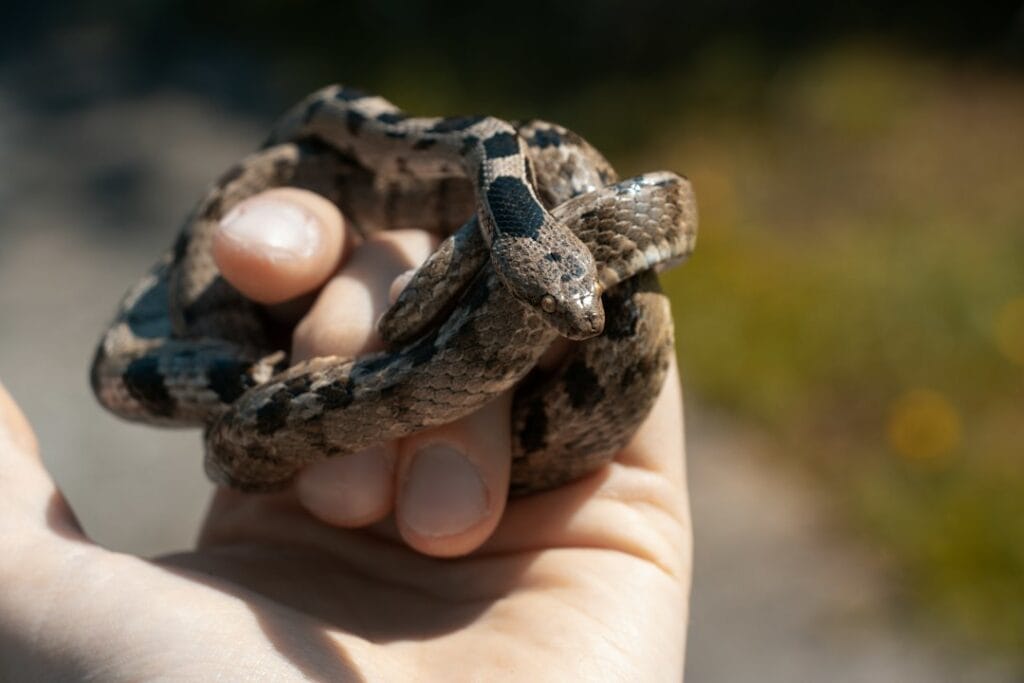Choosing pet snakes isn’t like picking out a new pair of shoes. Embarking on the journey to adopt a pet snake transcends mere selection; it’s about harmonizing with a sentient being that aligns with your life rhythm and spatial boundaries. Navigating the journey of choosing your ideal snake involves mastering their distinct personalities and aligning their care requirements with your everyday life.
We dive deep into setting up the perfect habitat for your slithery friend too. Think temperature control, cozy hides, and just-right humidity levels to keep them happy and healthy.
Feeding time can be tricky with snakes. But don’t worry; we’ve got you covered on what they eat, how often they need it, and tips for safe handling during meal times.
And because we want your pet snakes thriving under your care, we highlight common health issues—spotting early signs could save you both stress down the line.
Last but not least, owning pet snakes is rewarding but comes with its own set of challenges. We lay it all out so you know exactly what to expect before making the commitment. Thus, you’ll be well-equipped to navigate the road that lies before you.
Table Of Contents:
- Choosing the Right Pet Snakes for Your Home
- Common Health Issues in Pet Snakes
- Setting Up Your Snake’s Habitat
- Feeding Your Pet Snake
- The Pros and Cons of Keeping Pet Snakes
- Pet Snakes Yes or No
 AI illustration of a pet snake in habitat
AI illustration of a pet snake in habitat
Choosing the Right Pet Snakes for Your Home
Finding the perfect slithery companion involves more than just picking the one with the coolest colors. You’ve got to consider their lifestyle, much like choosing a roommate who won’t drive you up the wall.
First off, let’s talk size. While a Burmese python might seem like an epic choice, remember that these giants can grow over 18 feet long and need space bigger than your average closet. For beginners, something smaller like a corn snake or ball python is not only manageable but also less likely to turn your living room into its personal jungle gym.
Then there’s temperament. Want a snake that doesn’t mind being handled? Ball pythons are known for their docile nature, making them ideal pet snakes for those new to herpetology. On the flip side, if you prefer observing your pet’s natural behavior rather than cuddle sessions, king snakes make fascinating pets with their active hunting style.
Last but not least: lifespan and care requirements. These cold-blooded companions come with commitments—some species live upwards of 20 years. So make sure you’re ready for long-term care, including regular feeding of live or frozen prey, which PetMD explains in detail.
Here’s a list of 10 snake species that are popular as pets.
- Reticulated Python – Experienced: Reticulated pythons are one of the largest and longest snake species in the world, known for their striking pattern and considerable strength.
- Ball Python – Beginner: Ball pythons are known for their calm demeanor and are a favorite among beginners. They require moderate humidity and temperature control.
- California Kingsnake – Beginner: These snakes are hardy and adaptable, making them suitable for beginners. They are known for their ease of handling and feeding.
- Garter Snake – Beginner: Garter snakes are small and generally easy to care for, making them a good choice for novice snake owners. They have a varied diet compared to other snakes.
- Rosy Boa – Beginner: Rosy boas are known for their docility and ease of care. They require minimal space and have simple dietary needs.
- Hognose Snake – Beginner to Intermediate: Hognose snakes have a distinctive appearance and a generally docile nature. Their care requirements are straightforward, but they can sometimes be picky eaters.
- Royal Python (Ball Python) – Beginner: Listed again due to its popularity, the royal python (another name for the ball python) is renowned for its ease of care and handling.
- Milk Snake – Beginner to Intermediate: Milk snakes are colorful and relatively easy to care for, but they can be more active and slightly more challenging to handle than the most beginner-friendly snakes.
- Rainbow Boa – Intermediate: Rainbow boas have specific humidity requirements, making their care a bit more challenging than some other species on this list.
- Carpet Python – Intermediate to Expert: Carpet pythons are larger and more active, requiring more space and attention to environmental conditions than many beginner species
Common Health Issues in Pet Snakes
When it comes to our slithery friends, being proactive about their health is key. But even the most vigilant snake parents can run into some common issues.
Respiratory Infections
A sneezy snake might not just be reacting to dust. Respiratory infections are a frequent uninvited guest due to improper humidity or temperature levels in their habitat. Symptoms include difficulty breathing, mucus around the mouth or nostrils, and lethargy. Ensuring your pet’s enclosure has optimal humidity and temperature can ward off these pesky infections.
Spotting any symptoms of breathing troubles in your reptile warrants a prompt consultation with an experienced herpetological veterinarian to facilitate a speedy healing process.
Skin Conditions
Mites and fungal infections love to target snakes too. If your snake shows signs of irritation, like excessive soaking or rubbing against objects, it might be time for a closer inspection. Ensuring a snake’s skin fully renews through proper shedding is key in warding off dermatological troubles, as any hitches in this natural cycle could hint at deeper health issues necessitating attention.
Careful observation and regular habitat maintenance go a long way in keeping these common health woes at bay, but consult with a veterinarian specializing in reptiles if concerns arise.
If you have questions about the health of your pet snakes, you can sign up for an online vet consultation with Ask A Veterinarian. They are available 24/7 to answer questions.
To avoid unexpected health costs, check out Pet Assure Mint.
Setting Up Your Snake’s Habitat
Crafting a snug nook for your serpentine companion goes beyond mere looks; it’s vital for their well-being and joy. Here, we’ll walk through setting up the perfect habitat that mimics their natural environment as closely as possible.
Temperature Control
Snakes, being ectothermic creatures, depend on external warmth to maintain their internal temperature. A well-set-up terrarium should have a warm side and a cool side, allowing your snake to choose its comfort zone. The ideal temperature range varies depending on the species but generally falls between 75-85°F during the day. At night, temperatures can drop slightly but should remain above 70°F. To keep things consistent, use under-tank heaters or ceramic heat emitters and always monitor with reliable thermometers placed at both ends of the enclosure.
To dive deeper into understanding specific needs based on different types of snakes, Reptiles Magazine offers great insights.
Humidity Levels
Maintaining proper humidity is another key aspect often overlooked by new pet owners. If it is too dry, your snake might face shedding issues; being too moist could lead to skin infections or respiratory problems. For most snakes, humidity levels should be around 50-60%, although tropical species may need higher levels up to 80%. Using hygrometers will help you keep an eye on these numbers accurately.
A simple trick to boost humidity? Add a water bowl large enough for your snake to soak in if they wish—it helps them stay hydrated and supports healthy shedding.
Feeding Your Pet Snake
Getting the diet right for your pet snake isn’t just about keeping them alive; it’s about letting them thrive. Different snake breeds fancy different meals, ranging from chilled rodents to newborn rabbits. But remember, safety first—thawed food should never be microwaved but brought to room temperature naturally.
Safely feeding your snake is paramount. Use tongs to offer food and avoid associating your hand with mealtime to prevent accidental bites. Consistency in feeding schedules promotes healthy eating habits, typically ranging from once a week for adults to every 5 days for growing juveniles.
Digestion takes time and peace. Post-feeding, give your slithery friend some alone time—a day or two without handling helps prevent regurgitation issues which can stress both of you out more than necessary.
The Pros and Cons of Keeping Pet Snakes
So, you’re thinking about adding a slithering friend to your family? While owning a snake can captivate and intrigue, it also presents a series of distinctive hurdles to navigate. Here’s the lowdown on what to expect.
Pros
First off, snakes are pretty low-maintenance compared to furrier companions. They don’t need daily walks or constant attention. Plus, they’re silent creatures—your neighbors won’t even know you have one.
Bringing one into your home provides a peek into nature’s wonders without stepping outside. Watching them move and feed can be mesmerizing and educational.
Cons
But it’s not all smooth sailing. Setting up their habitat can hit your wallet hard initially. You’ll need special lighting, heating elements, and an enclosure that mimics their natural environment.
Finding food for your snake could also turn into an adventure since many pet snakes dine on live or frozen prey like mice or rats—a detail not everyone is comfortable with.
Last but not least, while they might not crave cuddles like a dog or cat would, some species do require regular handling to stay tame, which means overcoming any squeamishness about touching them.
Pet Snakes Yes or No
It’s important to pick pet snakes that resonate with your lifestyle. We’ve explored temperament, size, and care needs to help you make an informed decision.
Setting up a cozy habitat matters. Temperature control, humidity levels, and the right enclosure set the stage for a healthy snake.
Feeding your snake isn’t just about what they eat but how often and safely you provide their meals. It’s key to their well-being.
Spotting health issues early can save stress later on. Being proactive in prevention makes all the difference.
Having snakes as pets brings joy but also presents its own set of hurdles. Understanding what the future holds equips you for a thrilling adventure side by side.

